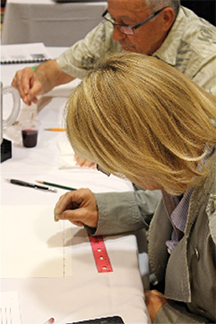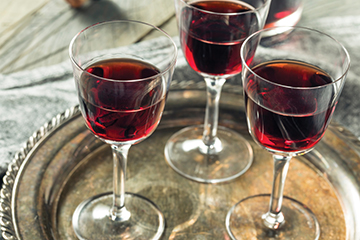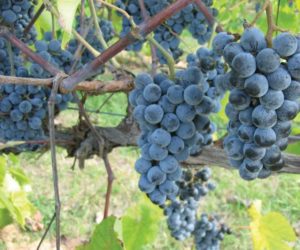
Malolactic fermentation (MLF) is widely used to soften the acidity of wines, increase textural aspects, and impart added flavor. A successful MLF will also increase a wine’s microbial stability. However, the bacteria that cause it tend to be very fastidious and often intimidate the beginning winemaker. The following information, although not guaranteeing a perfect MLF, will help the winemaker bring it to a successful conclusion.
What is Malolactic Fermentation?
Malolactic fermentation is the bacterial conversion of malic acid to lactic acid in wine or must. Malic acid, the primary acid of apples, is naturally occurring in grapes. It can be quite sharp with a flavor of green apples. It can also be a substrate for lactic acid bacteria, such as Oenococcus, Lactobacillus, and Pediococcus. Lactic acid, the acid found in cultured dairy products, is a softer, weaker acid than malic acid. The conversion of malic to lactic acid, which is usually carried out by Oenococcus oeni during winemaking, results in a softer wine with higher pH and lower acid. With a complete conversion, the wine becomes more microbiologically stable due to removal of the malic acid. Different strains of bacteria can have different flavor and textural impacts on wine. One of the strongest flavor impacts of MLF is the creation of the buttery compound diacetyl when the bacteria consume the citric acid present in grapes.
Malolactic bacteria (Oenococcus oeni) were considered spoilage organisms by much of the wine industry up until the mid-1900s. Through the 1980s, most MLF was spontaneous, often not taking place until the wine warmed up in the spring. This created problems because if MLF was desired, sulfur additions could not be made to stabilize the wine until after MLF was complete. Wines might have to wait six or more months after harvest without sulfur and would be vulnerable to infection by other lactic acid bacteria, Acetobacter or Brettanomyces. The first commercially available ML bacteria required a long (7–10 days) and careful build-up procedure. The first direct addition bacteria were not available until the early 1980s.
As mentioned earlier, the traditional way of handling MLF was through spontaneous conversion by whatever strains of bacteria existed in the winery and cooperage. These strains, once spring had arrived, were well-acclimated to the wine and were able to carry off a strong conversion (Ribereau-Gayon, Handbook of Enology). It was also believed that waiting longer to stabilize the wine resulted in better polymerization of the anthocyanins and hence, better color stability and intensity. However, the disadvantages tended to outweigh the advantages. Extended time without SO2 often resulted in severe Brettanomyces infections which created wines smelling somewhat like the zoo’s camel paddock. There was also the risk of a mixed bacterial population growing within the wine, increasing the potential for biogenic amine (toxins) and acetic acid formation.
With the advent of freeze-dried malolactic bacteria (MLB) cultures, winemakers were given much more control over timing and duration of MLF. Many added the bacteria at the beginning of fermentation but pulled back to post-fermentation additions after hearing that when Oenococcus oeni metabolizes sugar, it creates acetic acid. However, subsequent research by Dr. Sibylle Krieger-Weber in Germany showed that Oenococcus always preferentially metabolizes malic and citric acid before it consumes sugar. This research opened the door for co-inoculation of bacteria and yeast (with the caveat that wines with a history of stuck fermentations should NOT be co-inoculated). The decision to either co-inoculate or sequentially inoculate can affect flavor, microbial impact and stability.
Sequential vs. Co-inoculation
Sequential inoculation (after alcoholic fermentation) has many proponents. Sequential inoculation generally results in higher diacetyl levels. Some believe that it also results in more complexity. By adding the bacteria to a harsher environment (high alcohol), it produces a longer, slower MLF. There is a risk of infection by other microbes due to increased time without SO2. There is also a greater risk of a mixed bacterial culture that could result in biogenic amines. One recommendation by Vincent Renouf of Laffort in Bordeaux for sequential inoculation is to inoculate at 0 °Brix. The wine is still warm, which helps the bacteria. With the fermentation still going, the CO2 it generates helps keep the bacteria in suspension. Since the yeast is dying off at this point, the ML bacteria should quickly fill the microbial void. However, if the bacteria are inoculated in an alcoholic environment where the temperature is above 77 °F (25 °C), this can result in the death of the population.
In co-inoculation, the bacteria are added 24–48 hours after the yeast inoculation (after the yeast lag phase). If the pH is below 3.10 or the free SO2 is more than 50 ppm (and below 80 ppm) it is advisable to wait 48 hours. At the beginning of the alcoholic fermentation, the pH takes a temporary dip. Below 3.10, this dip could overly stress and possibly kill the bacteria in combination with active molecular SO2. By adding at the juice stage, the bacteria will acclimate to the alcohol as it slowly rises during the fermentation. Nick Smith, while doing research at the University of Minnesota, found that co-inoculated wines ended up finishing MLF at least two weeks before sequentially inoculated wines. This resulted in a shorter time without SO2 and less risk of mixed bacterial strains or other microbial infections. Co-inoculated wines generally show more fruit because the live yeast will consume the diacetyl. In a German trial comparing co-inoculated Riesling with the same wine sequentially inoculated, the sequentially inoculated wine had lost all Riesling character due to diacetyl. The co-inoculated wine tasted like a traditional Riesling, just somewhat softer.
As mentioned earlier, wines with a history of stuck or sluggish fermentations should avoid co-inoculation. Research in the 1980s showed that MLB could create acetic acid if it consumed sugar, but subsequent research has shown that the consumption of sugar will not take place until after the malic and citric acids are consumed. If an unexpected stuck alcoholic fermentation occurs, the wine should be treated with a moderate level of SO2 and/or Lysozyme, an enzyme that kills gram-positive bacteria.
Care and Feeding of Bacteria
Malolactic bacteria are very fastidious and have a narrow “ideal” range in which to work. Be sure to use a bacteria strain which will deal best with your winemaking conditions. In many cases certain challenging conditions might be unavoidable. However, the more stresses you can eliminate or reduce, the better the bacteria will perform. The main stresses on the bacteria are:
Alcohol
The ideal is <13% ABV. This is nearly impossible with red wines from warm climates. Because the stresses are additive, as the alcohol rises, the more important it is to reduce other stresses. Co-inoculated wines seem to tolerate higher alcohols (empirical observation in California with high alcohol fermentations).
pH
The ideal range is 3.20 to 3.50. Higher than pH 3.50, Oenococcus is more prone to acetic acid production after degradation of malic and citric acid. Also, above pH 3.50 other lactic acid bacteria species, such as Lactobacilli and Pediococci, may take over. Lower than 3.20, the bacterial metabolism slows or stops, depending on the strain and its acid tolerance. Co-inoculated wines tend to tolerate a lower pH.
Free and Total SO2
Free SO2 should be <8 ppm. This is a generalization since at higher pH the sulfur is less effective. Total SO2 should be <50 ppm. Much of the total SO2 is bound to aldehydes, which the bacteria can metabolize. By consuming the aldehydes, SO2 is released which could potentially damage or kill the bacteria.
Temperature
Rehydrate the bacteria at 68 °F (20 °C). For the actual MLF, sequentially inoculated wine should be kept at 64–72 °F (18–22 °C). Co-inoculated wines can go higher and have been successful up to 85 °F (29 °C).
Nutrition
Use a complete nutrient derived from yeast. For nitrogen, bacteria cannot take up ammonia (DAP), only organic N (amino acids, peptides). Feed the bacteria especially if the fermentation yeast had high nutrient demands or the alcoholic fermentation was a difficult one. If co-inoculating, don’t feed the bacteria until after alcoholic fermentation is complete and only if it shows signs of struggling.
Malic Acid Level
The ideal starting level of malic acid is 2–4 g/L. Less than 0.5 g/L will not sustain the bacterial population. Greater than 7 g/L is highly stressful for the bacteria.
Tannin
Recent research has shown a correlation between difficult MLFs and certain grape tannins (specifically, galloylated tannins which have a gallic acid molecule attached). Merlot is often high in these tannins and may have difficulty finishing MLF. Certain inactivated yeast preparations rich in polysaccharides seem to have a “protective” effect. When added to wine before inoculation with bacteria, they modify the effect of the tannins and make MLF easier.
Protocols for Rehydration and Build-up Cultures
As mentioned earlier, ML bacteria are very fastidious. Although some malolactic starter cultures can be inoculated directly to the wine, for best and fast distribution in the wine, rehydration is recommended. Temperatures of rehydration and timing are very important and they should be followed closely.
Rehydration of freeze-dried direct addition bacteria
1. Use non-chlorinated water at 68 °F (20 °C).
2. Rehydrate for no more than 15 minutes before adding to juice or wine.
3. Rehydration nutrients (read on).
Sequential inoculation
1. Inoculate near the end of alcoholic fermentation (approximately 0° Brix if fermentation is not stuck or sluggish).
2. If the yeast has high nutrient demands or the wine is nutrient-poor and/or highly tannic, supplement the wine with ML nutrients or rehydrate the bacteria in ML rehydration nutrients.
3. Once inoculated, keep the wine between 68-77 °F (20–25 °C), or 61-68 °F (16-20 °C) for high alcohol.
4. Make sure free SO2 is less than 8 ppm and total SO2 is less than 50 ppm (pH dependent).
5. Do not macro-aerate after alcoholic fermentation as lactic acid bacteria are sensitive to oxygen.
Co-inoculation
1. Preferably, add no more than 30 ppm SO2 to grapes or juice.
2. 24 hours after yeast addition, add ML bacteria (with proper rehydration).
3. Other than yeast nutrients, other ML nutrients are probably not necessary. If they are, add them after the completion of the alcoholic fermentation.
4. For red wine avoid vigorous pump-overs or vigorous punching down for 24 hours after inoculation and avoid overly hot fermentations: 85 °F (29 °C) maximum.
5. Below pH 3.10 wait to inoculate until pH has regained pH 3.10 or higher after the initial drop (approximately 48 hours).
6. Aeration during fermentation will not injure the MLB.
Conclusion
Ultimately, the decision whether or not to go through malolactic fermentation is both a stylistic and practical matter. MLF can change the flavor and aroma of wine, sometimes dramatically. It softens the wine while raising pH and lowering acidity. On the practical side, MLF removes a major bacterial substrate from the wine, thereby increasing its microbial stability. Used properly, a controlled MLF can be an invaluable tool.







